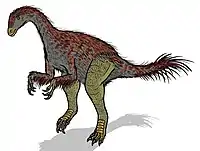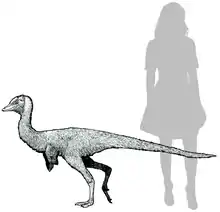| Bayin-Gobi Formation | |
|---|---|
| Stratigraphic range: | |
| Type | Geological formation |
| Unit of | Yin-E Basin |
| Underlies | Suhongtu Formation |
| Overlies | Permian metamorphic basement |
| Thickness | 100-2120 m |
| Lithology | |
| Primary | Mudstone, Siltstone, Conglomerate |
| Other | Sandstone |
| Location | |
| Region | Asia |
| Country | |
| Extent | Inner Mongolia |
The Bayin-Gobi Formation (simplified Chinese: 巴音戈壁组; traditional Chinese: 巴音戈壁組; pinyin: Bāyīn Gēbì Zǔ) (also known as Bayan Gobi, or Bayingebi Formation) is a geological formation in Inner Mongolia, north China, whose strata date back to Albian of the Early Cretaceous period. Dinosaur remains are among the fossils that have been recovered from the formation.
Paleobiota of the Bayin-Gobi Formation
Color key
|
Notes Uncertain or tentative taxa are in small text; |
Dinosaurs
| Genus | Species | Location | Stratigraphic Position | Material | Notes | Images |
|---|---|---|---|---|---|---|
| Alxasaurus | A. elesitaiensis | Elesitai Village | "Partial skeletons of several specimens."[1] | A therizinosauroid. |  | |
| Bannykus | B. wulatensis | Chaoge | "Partial and articulated skeleton lacking skull."[2] | An alvarezsauroid. |  | |
| Bayannurosaurus | B. perfectus | Chulumiao | Middle section of the Upper half of the Bayingebi Formation | "Nearly complete and semi-articulated skeleton."[3] | A large ankylopollexian. |  |
| Dromaeosauridae indet. | Indeterminate | Balongwula | "Partial hindlimbs, isolated manual ungual, and ribs."[4] | A dromaeosaurid, possibly a microraptorine. |  | |
| Penelopognathus | P. weishampeli | Qiriga Village | "Isolated right dentary."[5] | A hadrosauroid. | ||
| Psittacosaurus | P. gobiensis | Suhongtu | "Skull and skeletons of multiple specimens."[6] | A ceratopsian. | ||
See also
References
- ↑ Russell, D. A.; Dong, Z. (1993). "The affinities of a new theropod from the Alxa Desert, Inner Mongolia, People's Republic of China". Canadian Journal of Earth Sciences. 30 (10): 2107−2127. Bibcode:1993CaJES..30.2107R. doi:10.1139/e93-183.
- ↑ Xu, Xing; Choiniere, Jonah; Tan, Qingwei; Benson, Roger B.J; Clark, James; Sullivan, Corwin; Zhao, Qi; Han, Fenglu; Ma, Qingyu; He, Yiming; Wang, Shuo; Xing, Hai; Tan, Lin (2018). "Two Early Cretaceous Fossils Document Transitional Stages in Alvarezsaurian Dinosaur Evolution". Current Biology. 28 (17): 2853–2860. doi:10.1016/j.cub.2018.07.057. PMID 30146153.
- ↑ Xu, Xing; Tan, Qingwei; Gao, Yilong; Bao, Zhiqiang; Yin, Zhigang; Guo, Bin; Wang, Junyou; Tan, Lin; Zhang, Yuguang; Xing, Hai (2018). "A large-sized basal ankylopollexian from East Asia, shedding light on early biogeographic history of Iguanodontia". Science Bulletin. 63 (9): 556–563. Bibcode:2018SciBu..63..556X. doi:10.1016/j.scib.2018.03.016. PMID 36658842. S2CID 104031324.
- ↑ Pittman, M.; Pei, R.; Tan, Q.; Xu, X. (2015). "The first dromaeosaurid (Dinosauria: Theropoda) from the Lower Cretaceous Bayan Gobi Formation of Nei Mongol, China". PeerJ. 3: e1480. doi:10.7717/peerj.1480. PMC 4675113. PMID 26664809.
- ↑ Godefroit, P.; Li, H.; Shang, C.-Y. (2005). "A new primitive hadrosauroid dinosaur from the Early Cretaceous of Inner Mongolia (P.R. China)". Comptes Rendus Palevol. 4 (8): 697–705. Bibcode:2005CRPal...4..697G. doi:10.1016/j.crpv.2005.07.004.
- ↑ Sereno, P. C.; Xijin, Z.; Lin, T. (2009). "A new psittacosaur from Inner Mongolia and the parrot-like structure and function of the psittacosaur skull". Proceedings of the Royal Society B. 277 (1679): 199–209. doi:10.1098/rspb.2009.0691. PMC 2842669. PMID 19535376.
This article is issued from Wikipedia. The text is licensed under Creative Commons - Attribution - Sharealike. Additional terms may apply for the media files.